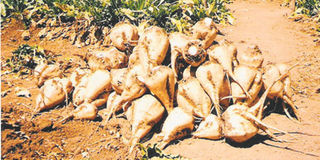Farmers try new source for sugar

A harvest of sugar beet. Photo/MATTHEW MWANGI
The country may soon start extracting sweeteners from alternative crops such as sugar beet, sweet sorghum and other such crops if the Sugar Act is changed to accommodate.
A group of farmers have been experimenting on the viability of sugar beet as an alternative in Kenya.
Sugar beet belongs to the family of Chenopodiaceae, which includes fodder beet and beet roots also known as red beets.
According to Wilfred Geita, a sugar engineer and former employee with Chemilili Sugar Company, and now the chairman of Kariita Sugar Beet Farmers SACCO, Fodder beets and beet roots have been grown in Nyandarua for over 60 years. European settlers grew them for domestic and animal feed. After independence, indigenous Kenyans continued growing them for the same purpose.
Turkey
Ambitious Mr Geita, decided to try out a few grammes of the sugar beet seeds, brought to him by a friend, from Turkey in 1995. Soil analysis were done on six different locations in Nyandarua production trials carried out between 1996 and 1997. Soil analysis results and sugar beet samples from the trials were sent to Sugar Research Institute in Turkey for analysis.
Doubt
In 1998, the second trial was conducted and it produced good results. “There is no doubt that sugar beet can grown in most parts of the country. Sugar cane farmers can use it as a rotational crop” Mr Geita said.
American Sugar Industry Biotech Council, describes sugar as a carbohydrate that occurs naturally in fruits and vegetables and highly concentrated in sugar beets and sugar cane. The sucrose from sugar beets is similar regardless of its original plant source or growing practices, such as growing using conventional, biotech or organic methods. The nutritional value and composition is identical.
Sugar beet has more comparative advantages over sugar cane. Sugar beet is planted via cuttings — stalks re-grow naturally up to ten times before replanting is required.
According to Mr Geita, sugar beet is most suited for temperate climate and can survive up to 42 degree centigrade, whereas sugar cane climate is tropical. Sugar beet first harvest takes 4-6 month, while sugar cane is 12 -18 months. Sugar beet has 16 - 20 per cent sugar content compared to 10 - 14 per cent in sugar cane.
Sugar beet requires a small investment and can be grown in a small piece of land as compared to sugar cane that requires large investment and land.
Capacity
The inclusion of sugar beet in the Sugar Act will allow diversification and thus reduce reliance on sugar cane. This would give consumers a choice and variety, in addition to enhancement of sugar production capacity in the country.
More small-scale farmers are likely to change the use of their land to sugar beet.
Mr Geita says trials began in Butere-Mumias in 2003 by Mumias Sugar Company and in 2005, the trials were extended among farming communities.
According to research findings in Kenya by Lund University, Centre for Sustainable Studies, Sweden, sugar beet requires high nutrient concentration in the soil.
Rooting
The soils should be deep as the sugar beet has a rooting depth greater than 150 centimetres. The pH ranges between 5.5 and 8.0, but the average is between 5.5 and 7.0.
The industrial production of sucrose from sugar beet differs slightly with that of sugar cane. The difference is on juice extraction. Sugar beets are washed and cut. The next stage is using a diffuser to extract the juice from the beet pulp, discharging the pulp to a dryer. The process yields a byproduct of pulp which can be used as a cattle feed.
Juice
Juice extraction form sugar cane is done by using roller mills to crush the stem — the byproduct of this, called bagasse is used to power the mill. The raw juice is purified using slaked lime. The remaining processes to final sugar are nearly the same for both sugar beet and sugar cane.
Existing factories would have to acquire specialised equipment for the extraction of juice from sugar beet.
Mr Geita and other members of Kariita Sugar Beet Farmers SACCO, which draws most of his members from Nyandarua, Nakuru, Molo and Laikipia, have formed a arm to lobby for the inclusion of sugar beet as an alternative source of sweeteners, in the Sugar Act.
Commercial use
According to Mr Geita, sugar beet seeds, produced by Syngenta Seed AB of Sweden, are locally available for research purposes, but not for commercial use.
Sugar from the tuber is produced in many countries, such as Spain, Turkey, Poland and German
According to the American Sugar Beet Growers Association, 54 percent of sugar produced in the United States is from sugar beet. The first American sugar beet factory was opened in 1879.
Pulp
Beets are a root crop and sugar is harvested from the root. Sometimes the beet tops are also used as food, and they can make up excellent animal feed.
After the process of extracting sugar from beets, the remaining pulp can be employed to make wet or dry mash for animals too.
Another use for sugar beets is to make an alternative fuel source, called biobutanol, though manufacture of this fuel is generally limited.
In appearance, the sugar beet root is nearly white in colour, not red or deep purple like most forms of beets sold directly for consumption.
Turnip
They’re less round than the average beet and more resemble a turnip. Average size of beets can vary.
For most people there is little taste difference between cane and beet sugar, since the same types of table sugar can be produced from each source.




